Brazing offers several advantages over either soldering or welding. It uses capillary action to draw the filler into the joint to create a strong, durable hold that is superior to welding or soldering. It offers a complete seal of the joint and, with the lower temperatures, offers the perfect option for joining different metals in a fast, reliable and durable way.
Basics of Brazing
In a very basic explanation, the filler material is applied to the joint after both parts or components have been cleaned and prepped. Depending on the shape and type of the parts, the brazing filler material can be applied to the interior or the exterior surface.
Heat is then applied not to melt either of the parts, but to melt the brazing filler material. The type of filler material selected has to be carefully considered to avoid any melting of the alloys in the parts. As this becomes liquid, capillary action draws the molten brazing filler into the joint in a uniform, precise and complete way for a full seal and joint.
Large Volume Processes
The use of furnace brazing offers the same exceptionally strong joint but allows for large numbers of parts to be brazed at the same time. As the filler melting is through heating to the correct temperature rather than the application of heat at a specific location, as in welding or soldering, this is a natural application for the process.
Even with very complex types of joints or assemblies, furnace brazing is a highly efficient process. All joints can be brazed at one pass through the furnace, reducing the overall cost per unit of manufacturing and assembly.
Additionally, with furnace brazing, complete control over all production is possible and easy to maintain. When companies have automated systems for placing the brazing filler material as well as for moving product through the furnace, even large volume, complex orders can be completed in extremely short turnaround times.



